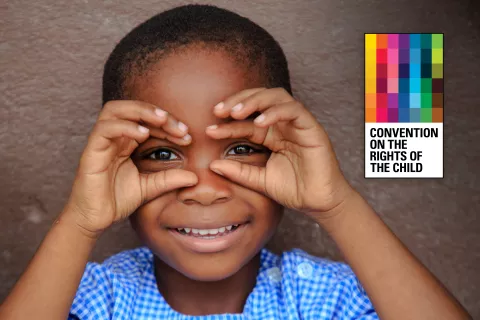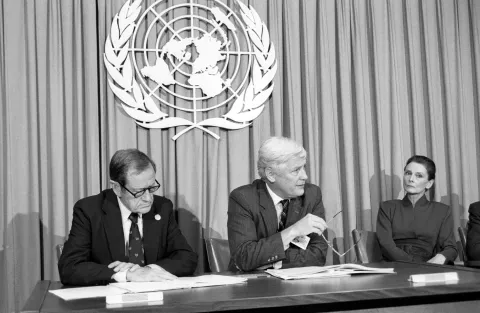Representing children: Then and now
A treaty for children that explains their rights: The Convention on the Rights of the Child turns 30.

The United Nations Convention on the Rights of the Child is the most widely ratified human rights treaty in history. The international agreement explains who children are, all their rights, and the responsibilities of governments to protect and fulfil these rights. All the rights are connected, they are all equally important and they cannot be taken away from children.
As the Convention turns 30, we take a look at some of these rights and representing children then and now:

Children must be registered when they are born and given a name which is officially recognized by the government. Children must have a nationality (belong to a country). Whenever possible, children should know their parents and be looked after by them.
(Left-right above)
Then in Thailand: A newborn receives an ID bracelet in the hospital.
Now in India: A healthy mother and her healthy newborn girl.

Children have the right to use their own language, culture and religion - even if these are not shared by most people in the country where they live.
(Left-right above)
Then in Ecuador: A boy who speaks Quechua Language stands between two adults.
Now in Viet Nam: A girl learns Mong, her mother-tongue, at school.

Every child has the right to be alive. Governments must make sure that children survive and develop in the best possible way.
(Left-right above)
Then in Ethiopia: A child in Ogaden is held tightly in a woman's arms, while facing the second straight year of drought.
Now in Congo: Natasha's skin lacks pigmentation. Sadly, not all children with albinism grow up in an inclusive environment like Natasha.

Every child with a disability should enjoy the best possible life in society. Governments should remove all obstacles for children with disabilities to become independent and to participate actively in the community.
(Left-right above)
Then in Cambodia: A boy maimed by a landmine enters the Wat Tan Temple in Phnom Penh.
Now in Ukraine: Hearing-impaired children work together. Volodymyr (left) runs a master class to create an interactive sign language alphabet using wooden blocks.

A child is any person under the age of 18.
(Left-right above)
Then in Sudan: A malnourished boy watches from behind a fence, as humanitarian aid is delivered.
Now in Nigeria: A girl in a hard-to-reach area is vaccinated at a mobile health clinic where community members learn about vital health practices such as exclusive breastfeeding.

Children can choose their own thoughts, opinions and religion, but this should not stop other people from enjoying their rights. Parents can guide children so that as they grow up, they learn to properly use this right.
(Left-right above)
Then in Peru: A girl studies her lessons by the late afternoon light at a local parish home.
Now in Mali: Fatoumata studies at home after dark. Many former school drop-outs like her now have access to educational support programmes that allow them to continue their studies.

Every child has the right to rest, relax, play and to take part in cultural and creative activities.
(Left-right above)
Then in Zimbabwe: Children invent a game using worn tyres.
Now in India: A girl shows her athleticism in the schoolyard.

Children should not be separated from their parents unless they are not being properly looked after – for example, if a parent hurts or does not take care of a child. Children whose parents don’t live together should stay in contact with both parents unless this might harm the child.
(Left-right above)
Then in Lesotho: A boy enjoys the rare protection of his father, as most men have left to find work elsewhere.
Now in Benin: Levi lives with his mother who attends college and his grandparents, while his father must travel for work.

All children have all these rights, no matter who they are, where they live, what language they speak, what their religion is, what they think, what they look like, if they are a boy or girl, if they have a disability, if they are rich or poor, and no matter who their parents or families are or what their parents or families believe or do. No child should be treated unfairly for any reason.
(Left-right above)
Then in Haiti: Children play in the streets as urban migration rises in the poorest nation in the western hemisphere.
Now in Lebanon: Syrian refugee children play in an informal settlement in Bekaa Valley.

Every child has the right to an education. Primary education should be free. Secondary and higher education should be available to every child. Children should be encouraged to go to school to the highest level possible. Discipline in schools should respect children’s rights and never use violence.
(Left-right above)
Then in Romania: A girl studies in Grade 5 where classrooms are often overcrowded with few books or other educational materials.
Now in Mongolia: A girl attends kindergarten as part of an early childhood development programme.

Governments must do all they can to make sure that every child in their countries can enjoy all the rights in this Convention.
(Left-right above)
Then in Haiti: A girl is vaccinated by a healthcare worker.
Now in Cote d'Ivoire: A girl, Ahou Marie, leads a meeting with the Minister of Communication and Media as part of World Children's Day celebrations in the country.




